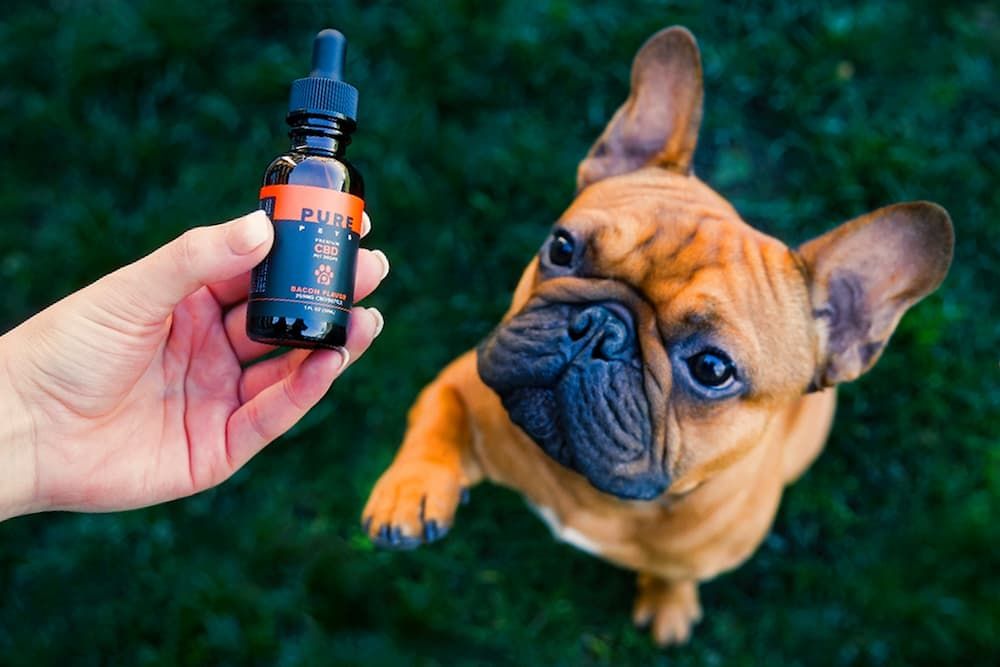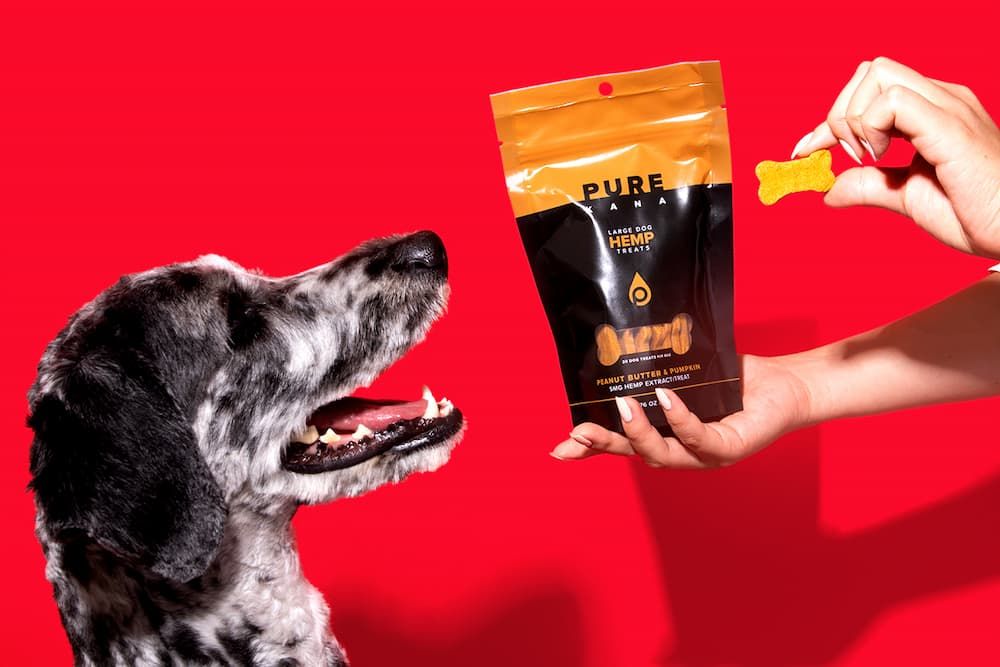What are the Side Effects of CBD Oil in Dogs?
Written by:
Author: Vicki Smirnova
Vicki Smirnova is a professional writer and editor who adores animals and helps readers get along well with their pets. She has been working in digital media for more than 5 years and has great experience writing content about lifestyle, including pets. Vicki specializes in dog health and nutrition, cat feeding, dog training. She is an aquarium lover and is passionate to write about fish care at home. Also, Vicki headed several websites and worked as a news editor.
View all 244 articlesLearn about our editorial process and veterinary review board.
Viewed: 195
Updated on: 10/07/2021
CBD products have quickly become the wellness trend of the decade. However, its popularity now extends beyond human use, with many pet owners considering using CBD on their dogs.
While formal research is limited, plenty of anecdotal evidence suggests that CBD has the potential to treat joint pain, stimulate appetite, lessen anxiety, and possibly limit seizures in our canine companions.
Still, some pet owners are cautious about using the compound over the potential for adverse side effects. In most instances, however, side effects generally result when cheap, low-end products are purchased. This is why, for those that are considering buying CBD for dogs, we always recommend using pure, hand-crafted products from well-established, reputable labels.
What Is CBD?
Cannabidiol, is a naturally occurring compound found in cannabis. While the plant contains at least 113 different cannabinoids, CBD is the second most abundant.
THC, or tetrahydrocannabinol, is the most abundant compound that causes the famous mind-altering effects of marijuana. However, unlike THC, CBD is non-intoxicating and does not produce a high.
Stringent legislation in the US means that legal CBD products must contain 0.3% THC or less. To regulate this, CBD must be extracted from industrial hemp, a crop rich in CBD but with minimal amounts of THC. This is true for both human and pet cannabidiol products.
CBD is largely sought after for its range of health benefits. In various human studies, the compound has shown anti-inflammatory properties, which has made it a popular remedy for conditions such as arthritis.
People also use oils and topicals to tackle anxiety, stress and to encourage a sense of well-being.
How Does CBD Interact with a Dog’s Endocannabinoid System?
As mentioned above, CBD does show benefits for people. Therefore, many have theorized it could be helpful for dogs. So, how does this work on a biological level?
CBD interacts with the body’s endocannabinoid system. This complex biological network regulates immune response, metabolism, memory, pain response, and many more things. Within this system exists two important receptors:
CB1 receptors are located throughout the brain and central nervous system, and CB2 receptors, which are largely located in the immune system and gut.
While CBD doesn’t specifically bind to either receptor, it does influence their behavior. Some research suggests this interaction is responsible for its benefits.
Just like people, dogs have an endocannabinoid system. [1] In fact, some studies have found that canines have even more CB1 receptors in the brain than humans, making them more sensitive to endocannabinoids like cannabidiol, and primarily, THC.
Are There Benefits for Dogs Consuming CBD?
Various studies have investigated the impact CBD may have on dogs, the majority of which have focused on pain, inflammation, and epilepsy.
Pain reduction: One study, published in Frontiers in Veterinary Science, investigated the link between CBD and osteoarthritic-related pain. [2] Using a dosage guide of 2mg per kg of body weight, they treated each dog with CBD oil every 12hrs for a 2-week period.
After a final veterinary assessment, the results showed a significant decrease in pain and increased mobility amongst the dogs. And importantly, no side effects were reported by the dog owners.
Allergy relief: Many pet owners will be well aware of the complications of skin allergies, especially in breeds such as bulldogs and retrievers. Often clinically-approved medications provide little relief to the inflammatory rashes and scabbing that dogs may experience.
One study, conducted in 2012 by the American Journal of Veterinary Research, looked at whether CBD could combat allergies, or more specifically, atopic dermatitis. [3] Researchers found that cannabidiol could protect against allergic inflammatory disorders, and they believe this was due to CBD’s immunosuppressive properties, which work particularly well with inflammation.
The Potential Side Effects of CBD for Dogs
While CBD is considered generally safe, dogs may experience some uncomfortable side effects, just like humans do. Adverse reactions can occur if:
- The CBD dosage is too high.
- A product contains artificial flavorings, colorings, or other irritants.
- The product contains large quantities of THC.
- The dog is taking conflicting medication.
Because of this, it’s important to be able to identify specific side effects dogs may exhibit. Below are some indicators.
Dry Mouth
Considered a minor side effect, some dogs may experience a dry mouth after consuming CBD. Although most research has been conducted on humans, research suggests that cannabidiol decreases saliva production as it interacts with the oral glands.
Dog owners may notice a myriad of signs, including increased drinking, bad breath, very thick saliva, and of course, dry gums.
Fatigue
As well as being a common side effect for humans, dogs may also experience fatigue and lethargy with CBD use. This may manifest in the form of increased sleeping, a lack of mobility, and sometimes, a decrease in appetite.
In one particular study conducted in 2020, researchers investigated how well dogs would respond to a gradual increase in CBD and THC consumption. Over the course of 6 weeks, the CBD dosage was gradually increased from 2-62mg/kg. [4]
The researchers found mild side effects in 94.9% of dogs and severe side effects (like lethargy) in 0.8% of dogs. However, they noticed a correlation between adverse side effects and higher levels of THC.
They concluded the study by stating that the dogs handled the escalation of cannabidiol-rich oils well.
Vomiting and Diarrhea
What might begin as nausea may lead to more severe side effects like vomiting or diarrhea. As well as being emotionally stressful for pets, this may indicate a more serious problem inside the body.
A 2018 study looking into adverse side effects of CBD for dogs found some interesting results on this topic. [5] Researchers dosed male beagles with either 10mg/per kg or 20mg/per kg over six weeks. To avoid bias over one product type, they also used a range of products, including CBD capsules, topicals, and oils.
The study reported gastrointestinal upset (diarrhea) in every dog and vomiting in 20% of the dogs. The study also considered the risk of long-term liver toxicity if CBD is used at a clinical dosage and for a lengthy time.
However, researchers pointed out that the side effects may be attributed to external stress, as the beagles were placed in new housing, surrounded by unfamiliar people, and given different diets.
Can You Avoid Side Effects When Giving Your Dog CBD?
Many brands have recognized the growing demand for CBD pet products, from chicken-flavored CBD oils to sweet potato treats. Because of this, it’s never been more important to carefully choose what you buy – and where you buy it.
While the suggestions below may not eradicate side effects, they may help decrease the risk.
1. Check for Lab Reports
As briefly mentioned, pets are susceptible to THC, and consumption could lead to a loss of coordination and muscle control. Because of this, low levels of THC are essential in cannabidiol products for dogs.
Owners can check how much THC a product contains by looking at its lab reports. Trustworthy brands will always offer detailed and transparent information that shows exactly what cannabinoids their product contains.
Additionally, these lab testings should be conducted by a third party to ensure no bias.
2. Pay Attention to Dosage Suggestions
Dosage plays a vital role in CBD for dogs. Too much CBD and additional terpenes and cannabinoids may increase the chance of diarrhea and fatigue.
While no “ideal” dosage exists for any single pet, good CBD brands will offer dosage guidance with their products. Better yet, some brands will specifically tailor their products towards small or large breeds.
This can be a godsend when buying cannabidiol for pets, as it takes out the stress of owners having to work out serving sizes. In general, many brands advise 1-2 milligrams of CBD for every 10 pounds of weight.
3. If in Doubt, Ask a Professional
While owners undoubtedly know their pets the best, getting advice from a medical professional is an important step to take.
They can advise on what health conditions your dog is currently facing and whether taking CBD could be beneficial.
Additionally, as dogs get older, the likelihood of them already consuming medication is high. Little research has been conducted on how CBD interacts with drug combinations, but we know it can pose complications in human use.
Licensed veterinarians may better understand this synergistic effect and can help assess the health risks.
Final Thoughts on Side Effects of CBD in Dogs
Despite the reported side effects like dry mouth and fatigue, most clinical studies agree that CBD has a good safety profile for dogs. Many owners are already using it to combat pain, anxiety, and even allergies experienced by their pets.
It’s also encouraging that hemp-based dog products are legal and approved for sale in countries like Canada by the Veterinary Health Products Act Industrial Hemp Regulations. [6]
However, it’s important to reiterate that there is no definitive research on the side effects or benefits of CBD for pets. Additionally, since the quality of cannabidiol products is so loosely regulated in the US, it’s essential to only purchase from trusted brands.
For those curious about using CBD for dogs, it’s highly recommended to visit a certified veterinarian to discuss the topic.
Article Sources:
- Silver, Robert. “The Endocannabinoid System of Animals.” PubMed Central (PMC), 1 Sept. 2019, ncbi.nlm.nih.gov/pmc/articles/PMC6770351/#B87-animals-09-00686.
- Trumble, Troy. “Pharmacokinetics, Safety, and Clinical Efficacy of Cannabidiol Treatment in Osteoarthritic Dogs.” Frontiers in Veterinary Science, 25 Feb. 2018, internal-journal.frontiersin.org/articles/10.3389/fvets.2018.00165/full.
- “Cannabinoid Receptor Type 1 and 2 Expression in the Skin of Healthy Dogs and Dogs with Atopic Dermatitis.” American Journal of Veterinary Research, researchgate.net/publication/228080404_Cannabinoid_receptor_type_1_and_2_expression_in_the_skin_of_healthy_dogs_and_dogs_with_atopic_dermatitis.
- Vaughn, Dana. “Preliminary Investigation of the Safety of Escalating Cannabinoid Doses in Healthy Dogs.” PubMed Central (PMC), 1 Jan. 2020, ncbi.nlm.nih.gov/pmc/articles/PMC7029731/.
- McGrath, Stephanie, et al. “A Report of Adverse Effects Associated With the Administration of Cannabidiol in Healthy Dogs.” Journal of the American Holistic Veterinary Medical Association, ahvma.org/wp-content/uploads/AHVMA-2018-V52-CannabisAdverseEffects.pdf.
- Chicoine, Alan, et al. Composition of Unapproved Cannabinoid Products Directly Marketed to Canadian Pet Owners. ncbi.nlm.nih.gov/pmc/articles/PMC7155876/.
 Dog Care Why Does My Dog Poop So Much? Determining A Healthy Poop Schedule For Your Dog
Dog Care Why Does My Dog Poop So Much? Determining A Healthy Poop Schedule For Your Dog - 184
- 0
 Dog Care When Is It Too Hot To Walk Your Dog? Tips On Walking Your Dog In Hot Weather
Dog Care When Is It Too Hot To Walk Your Dog? Tips On Walking Your Dog In Hot Weather - 125
- 0
 Dog Veterinary Tips Tear Stains on Dogs: How to get rid of tear stains on dogs? (Vet Advice)
Dog Veterinary Tips Tear Stains on Dogs: How to get rid of tear stains on dogs? (Vet Advice) - 104
- 0
 Dog Veterinary Tips Why is my Dog throwing up: Causes and Preventing (Veterinary Advice)
Dog Veterinary Tips Why is my Dog throwing up: Causes and Preventing (Veterinary Advice) - 23424
- 5
 Dog Care Why Is My Dog Bleeding From Its Butt? Causes and treatment of rectal bleeding in the dog
Dog Care Why Is My Dog Bleeding From Its Butt? Causes and treatment of rectal bleeding in the dog - 22076
- 0
 Dog Care My Dog Keeps Scratching His Mouth: Reasons Why Your Dog Scratching Face
Dog Care My Dog Keeps Scratching His Mouth: Reasons Why Your Dog Scratching Face - 17561
- 1
























